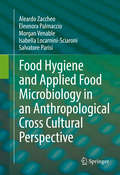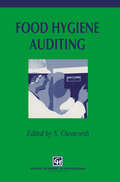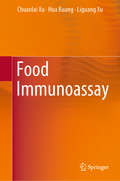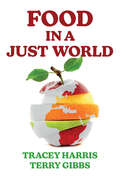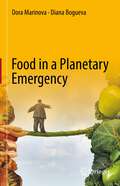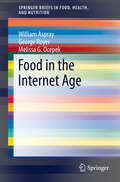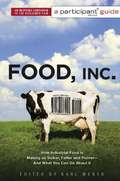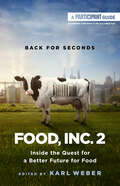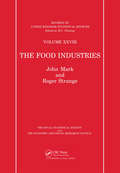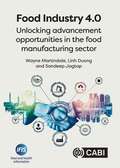- Table View
- List View
Food Hydrocolloids (Routledge Revivals #3)
by Martin GlicksmanFirst Published in 1982, this three-volume set explores the value of hydrocolloids in food. Carefully compiled and filled with a vast repertoire of notes, diagrams, and references this book serves as a useful reference for dieticians and other practitioners in their respective fields.
Food Hydrocolloids (Routledge Revivals #3)
by Martin Glicksman Steen Højgaard Christensen Joseph A. Grover Carl T. Herald John D. Keller Christopher McIntyre William R. ThomasFirst Published in 1982, this three-volume set explores the value of hydrocolloids in food. Carefully compiled and filled with a vast repertoire of notes, diagrams, and references this book serves as a useful reference for dieticians and other practitioners in their respective fields.
Food Hydrocolloids as Encapsulating Agents in Delivery Systems
by Adil Gani F. A. Masoodi Umar Shah Shah AsimaThis book addresses the use of food hydrocolloids as agents for encapsulating biological active ingredients. It details the challenges of poorly-controlled rate of hydration, thickness, decrease in viscosity upon storage, and susceptibility to microbial contamination. Food Hydrocolloids as Encapsulating Agents in Delivery Systems briefly describes various emerging biomaterials including food gums, starches, beta glucans, and proteins for their potential role as wall material in the development of nutraceutical delivery systems. Further, it describes different techniques of fabrication of nanodelivery systems. Features: Provides an introduction to food hydrocolloids as encapsulating agents Covers starches and their derivatives as delivery systems Includes gum-based delivery systems Discusses the classification, isolation, and purification of protein delivery systems This book would be helpful to food scientists and pharmaceutical scientists working in areas including nanotechnology, polymer chemistry, and nutraceutical delivery, as well as regulators and government researchers in US FDA, USDA, and UK FSA regulatory agencies.
Food Hydrocolloids as Encapsulating Agents in Delivery Systems
by Adil Gani F. A. Masoodi Umar Shah Shah AsimaThis book addresses the use of food hydrocolloids as agents for encapsulating biological active ingredients. It details the challenges of poorly-controlled rate of hydration, thickness, decrease in viscosity upon storage, and susceptibility to microbial contamination. Food Hydrocolloids as Encapsulating Agents in Delivery Systems briefly describes various emerging biomaterials including food gums, starches, beta glucans, and proteins for their potential role as wall material in the development of nutraceutical delivery systems. Further, it describes different techniques of fabrication of nanodelivery systems. Features: Provides an introduction to food hydrocolloids as encapsulating agents Covers starches and their derivatives as delivery systems Includes gum-based delivery systems Discusses the classification, isolation, and purification of protein delivery systems This book would be helpful to food scientists and pharmaceutical scientists working in areas including nanotechnology, polymer chemistry, and nutraceutical delivery, as well as regulators and government researchers in US FDA, USDA, and UK FSA regulatory agencies.
Food Hygiene and Applied Food Microbiology in an Anthropological Cross Cultural Perspective
by Aleardo Zaccheo Eleonora Palmaccio Morgan Venable Isabella Locarnini-Sciaroni Salvatore ParisiThe book demonstrates that food safety is a multidisciplinary scientific discipline thatis specifically designed to prevent foodborne illness to consumers. It is generally assumedto be an axiom by both nonprofessionals and professionals alike, that the mostdeveloped countries, through their intricate and complex standards, formal trainingsand inspections, are always capable of providing much safer food items and beveragesto consumers as opposed to the lesser developed countries and regions of the world. Clearly, the available data regarding the morbidity and the mortality in different areasof the world confirms that in developing countries, the prevalence and the incidence ofpresumptive foodborne illness is much greater. However, other factors need to be takeninto consideration in this overall picture: First of all, one of the key issues in developingcountries appears to be the availability of safe drinking water, a key element in anyfood safety strategy. Second, the availability of healthcare facilities, care providers, andmedicines in different parts of the world makes the consequences of foodborne illnessmuch more important and life threatening in lesser developed countries than in mostdeveloped countries. It would be therefore ethnocentric and rather simplistic to statethat the margin of improvement in food safety is only directly proportional to thelevel of development of the society or to the level of complexity of any given nationalor international standard. Besides standards and regulations, humans as a whole haveevolved and adapted different strategies to provide and to ensure food and water safetyaccording to their cultural and historical backgrounds. Our goal is to discuss and tocompare these strategies in a cross-cultural and technical approach, according to the realities of different socio-economic, ethnical and social heritages.
Food Hygiene, Microbiology and HACCP
by S. ForsytheFood microbiology is a fascinating and challenging science. It is also very demanding with a constantly changing sea of guidelines, regulations and equip ment. Public concerns over food safety issues can overemphasize certain risks and detract from the normal hygienic practice of food manufacturers. This new edition aims to update anyone concerned with the hygienic production of food on key issues of HACCP, food microbiology and the methods of microbe detection. I have taken a 'crystal ball' approach to certain topics. The use of rapid techniques such as lux gene technology and polymerase chain reaction (DNA probes) are progressing so rapidly in the research laboratory that when this book is in print the techniques may be more readily available. New methods for investigating viral gastroenteritis due to small round structured viruses (SRSV) have been developed past the 'research' stage and may become more standard in the next few years. Undoubtedly this will alter our understanding of the prevalence of viral food poisoning. I have also included issues such as new variant CJD (associated with BSE infected cattle) which at the time of writing has only caused the deaths of 20 people, but due to the uncertain incubation time could be a far more serious problem. In the UK there has been a much publicised outbreak of Escherichia coli 0157:H7 which has resulted in a government inquiry and the recommenda tion of the generic HACCP approach. Hence this approach to HACCP imple mentation has been included.
Food Hygiene, Microbiology and HACCP
by P.R. Hayes S.J. ForsytheFood microbiology is a fascinating and challenging science. It is also very demanding with a constantly changing sea of guidelines, regulations and equip ment. Public concerns over food safety issues can overemphasize certain risks and detract from the normal hygienic practice of food manufacturers. This new edition aims to update anyone concerned with the hygienic production of food on key issues of HACCP, food microbiology and the methods of microbe detection. I have taken a 'crystal ball' approach to certain topics. The use of rapid techniques such as lux gene technology and polymerase chain reaction (DNA probes) are progressing so rapidly in the research laboratory that when this book is in print the techniques may be more readily available. New methods for investigating viral gastroenteritis due to small round structured viruses (SRSV) have been developed past the 'research' stage and may become more standard in the next few years. Undoubtedly this will alter our understanding of the prevalence of viral food poisoning. I have also included issues such as new variant CJD (associated with BSE infected cattle) which at the time of writing has only caused the deaths of 20 people, but due to the uncertain incubation time could be a far more serious problem. In the UK there has been a much publicised outbreak of Escherichia coli 0157:H7 which has resulted in a government inquiry and the recommenda tion of the generic HACCP approach. Hence this approach to HACCP imple mentation has been included.
Food Immunoassay
by Chuanlai Xu Hua Kuang Liguang XuThis book systematically covers immunoassays for food, presenting detailed approaches such as antigen design, food matrix pre-treatment and detection format optimization for 9 classes of food hazards and nutrition constituents. Offering ideas on how to improve the efficiency of recognized xenobiotics and food contents, this practical book also describes the discovery and utilization of novel immune agents like aptamer and molecular imprinted polymers in food analysis. It is intended for a broad range of areas, including biologists and food chemists, and is sure to become a key reference resource for students and professionals alike.
Food in a Just World: Compassionate Eating in a Time of Climate Change
by Tracey Harris Terry GibbsFood in a Just World examines the violence, social breakdown, and environmental consequences of our global system of food production, distribution, and consumption, where each step of the process is built on some form of exploitation. While highlighting the broken system’s continuities from European colonialism, the authors argue that the seeds of resilience, resistance, and inclusive cultural resurgence are already being reflected in the day-to-day actions of communities around the world. Calling for urgent change, the book looks at how genuine democracy would give individuals and communities meaningful control over the decisions that impact their lives when seeking to secure humanely this most basic human need. Drawing on the perspectives of advocates, activists, workers, researchers, and policymakers, Harris and Gibbs explore the politics of food in the context of capitalist globalization and the climate crisis, uncovering the complexities in our relationships with one another, with other animals, and with the natural world.
Food in a Planetary Emergency
by Dora Marinova Diana BoguevaThis book Food in a Planetary Emergency is a timely overview of the current food systems and the required transformations to respond to the challenges of climate change, population pressures, biodiversity loss and use of natural resources, such as soils, water and phosphorus. This book takes a planetary health perspective which explores the links between natural systems and human wellbeing implying that there is need for united actions to achieve important environmental and population health co-benefits.This book outlines that the foundation of planetary health is sustainability. It addresses environment and climate change emergency as a global agenda, however, emphasises the urgency of the sustainability perspective which integrates a wide spectrum of issues that require integrated solutions to offer better prospects for humanity. This book drives this argument further through the global Sustainable Development Goals (SDGs) where food is not just SDG2 but transcends all 17 goals.This book tackles the problems of food production and consumption at a global, industry and individual level linking it to topics related to the natural environment, climate change, waste, marketing, new ways of producing food and providing alternative proteins, mitigating non-communicable diseases, flexitarianism and the role of Generation Z in the emerging dietary choices.This book benefits readers with understanding the importance and intricacy of their dietary choices at a point in time when our planet is facing an emergency triggered by long-term dependence on fossil fuels and artificial fertilisers but also by the ways we have provided food. However, this book also delivers the message that safeguarding and sustaining planetary health is possible.
Food in the Internet Age (SpringerBriefs in Food, Health, and Nutrition)
by William Aspray George Royer Melissa G. OcepekThis book examines food in the United States in the age of the Internet. One major theme running through the book is business opportunities and failures, as well as the harms to consumers and traditional brick-and-mortar companies that occurred as entrepreneurs tried to take advantage of the Internet to create online companies related to food. The other major theme is the concept of trust online and different models used by different companies to make their web presence seem trustworthy. The book describes a number of major food companies, including AllRecipes, Betty Crocker, Cook's Illustrated, Epicurious, Groupon, OpenTable, and Yelp. The book draws on business history, food studies, and information studies for its approach.
Food in the Making of Modern Korea: A Handbook
by Cherl-Ho LeeThis handbook offers an updated and comprehensive presentation of knowledge on Korean modern and contemporary food history. It covers the changes in food availability, nutrition, and the health status of Koreans, and the Korean food industry's development from the late period of Joseon dynasty in the mid-19th century, to the present. This period includes the severe poverty and food shortage of the Joseon dynasty, followed by the Japanese invasion, Independence and the South-North division, the Korean war, and rapid industrial development. The influence of national and international environments and political changes during the last 150 years on the Korean food security and the nutritional situation of the people is demarcated. In doing so, the author makes novel suggestions on possible contributions to alleviate the world food crisis in the future. Relevant to food historians and food scientists, and East Asian studies scholars with a particular interest in Korean culture and history,this is a pioneering work that elucidates the driving forces for the development and betterment of Korean society—through food acquisition.
Food Inc.: How Industrial Food is Making Us Sicker, Fatter, and Poorer-And What You Can Do About It (A\participant Media Guide Ser.)
by Karl WeberFood, Inc. is guaranteed to shake up our perceptions of what we eat. This powerful documentary deconstructing the corporate food industry in America was hailed by Entertainment Weekly as "more than a terrific movie-it's an important movie.” Aided by expert commentators such as Michael Pollan and Eric Schlosser, the film poses questions such as: Where has my food come from, and who has processed it? What are the giant agribusinesses and what stake do they have in maintaining the status quo of food production and consumption? How can I feed my family healthy foods affordably?Expanding on the film's themes, the book Food, Inc. will answer those questions through a series of challenging essays by leading experts and thinkers. This book will encourage those inspired by the film to learn more about the issues, and act to change the world.
Food, Inc. 2: Inside the Quest for a Better Future for Food
by Participant and Karl WeberAn eye-opening guide to how America feeds itself and an essential companion book to the new documentary America&’s food system is broken, harming family farmers, workers, the environment, and our health. But it doesn&’t have to be this way. Here, brilliant innovators, scientists, journalists and activists explain how we can create a hopeful new future for food, if we have the courage to seize the moment. In 2008, the award-winning documentary Food, Inc. shook up our perceptions of what we ate. Now, the movie&’s timely sequel and this new companion book will address the remarkable developments in the world of food—from lab-grown meat to the burgeoning food sovereignty movement—that have unfolded since then. Featuring thought-provoking original essays from: Michael Pollan • Eric Schlosser • David E. Kelley and Andrew Zimmern • Senator Cory Booker • Sarah E. Lloyd • Carlos A. Monteiro and Geoffrey Cannon • Lisa Elaine Held • Larissa Zimberoff • Saru Jayaraman • Christiana Musk • Nancy Easton • Leah Penniman • David LeZaks and Lauren Manning • The Coalition of Immokalee Workers • Michiel Bakker • Danielle Nierenberg This book is the perfect roadmap to understanding not only our current dysfunctional food system, but also what each of us can do to help reform it.
Food Industries
by J. Mark R. Strange J. BurnsThis volume deals with the diverse range of industries concerned with the supply and processing of food in the UK. It covers sources relating to food production and processing, including foodstuffs supplied from abroad, and also fish supply and processing.
Food Industries
by J. Mark R. Strange J. BurnsThis volume deals with the diverse range of industries concerned with the supply and processing of food in the UK. It covers sources relating to food production and processing, including foodstuffs supplied from abroad, and also fish supply and processing.
Food Industries Manual
by Christopher G.J. Baker M.D. Ranken R.C. KillIt is a measure of the rapidity of the changes The work has been revised and updated, and taking place in the food industry that yet another following the logic of the flow sheets there is some edition of the Food Industries Manual is required simplification and rearrangement among the chap after a relatively short interval. As before, it is a ters. Food Packaging now merits a separate pleasure to be involved in the work and we hope chapter and some previous sections dealing mainly that the results will continue to be of value to with storage have been expanded into a new readers wanting to know what, how and why the chapter covering Food Factory Design and Opera food industry does the things which it does. tions. For this edition we have made a major depar There is one completely new chapter, entitled ture from the style of earlier editions by comple Alcoholic Beverages, divided into Wines, Beers tely revising the layout of many of the chapters. and Spirits. There is a strain of thought which Previously the chapters were arranged as a series does not yet consider the production of those of notes on specific topics, set out in alphabetical drinks to be a legitimate part of the food industry, order in the manner of an encyclopaedia.
Food Industries Manual
by M. D. RankenIt is a pleasure to be involved in yet another edition the enforcement system and its officers, and the of the Food Industries Manual, and to know that the appearance of many more consultants, advisors and training specialists all claiming to assist manu book remains in sufficiently high demand for a new edition to be necessary. The work of revision and facturers in the discharge of what are described as updating has been rewarding to us and we hope that new and onerous duties. In reaction to all this, food the result will be found at least equally helpful to manufacturers are learning so to order their opera those who use it. tions that their reliability and their commitment to In the five years since the last edition the growth quality and good workmanship can be routinely of the chilled foods sector, in both quantity and demonstrated. The touchstone of this has become quality-with much more refrigeration available accreditation of the manufacturer's systems by an and in use, with close control of refrigeration tem independent authority, for instance that they peratures, storage times, storage temperatures, conform with the International Standard for tra?Sport conditions and display conditions, and Quality Systems, ISO 9000, or its British Standard with better information on labels and elsewhere equivalent, BS 5750. These and related matters are about shelf life and the handling of products-has dealt with in another new Chapter, on Food Issues.
Food Industry 4.0: Unlocking Advancement Opportunities in the Food Manufacturing Sector
by Dr Wayne Martindale Dr Linh Duong Dr Sandeep JagtapThis book provides industry insights and fresh ideas for the advancement of the most vital global industry - food. Drawing on their industry and academic expertise the authors have identified three controlling aspects of food business operations that can unleash long term success: consumer health and wellbeing; product and process sustainability; and harnessing advances in digitalization.. If developed to their maximum potential these factors have the capability to revolutionize the food sector. Food Industry 4.0 highlights advancement opportunities for the food manufacturing sector, including innovation in products, processes and services, as it seeks to combine productive, efficient and sustainable practices. The contents address: Mapping data, new approaches for food system applications. The perfect meal and making a balanced global diet possible. Industry 4.0 applications in the food sector: robotics and automation, big data, Internet of Things, cybersecurity. Resource utilization in the food manufacturing sector. Resilience and sustainability in food supply chains. Environmental and social governance in our food system. It is of significant benefit to food industry practitioners working in operational and product development roles, academic researchers, policy makers, students, and food sector professionals.
Food Industry and the Environment: Practical Issues and Cost Implications
by J. M. DalzallAll areas of industry are facing increasing pressure from governments and consumers to be more environmentally aware. The food industry is no exception, and an increasing number of companies have made the decision to implement an environmental policy. These organisations will benefit from this book, which has been written to provide a broad but detailed introduction to the topic of environmental issues and their cost implica tions to the food industry. Throughout the text the authors have approached the subject from a practical angle, and have borne in mind the environmental, production or site manager who is grappling with the problem of how to implement such a policy. This book begins by considering the raw materials that are used in the food industry, whether derived from animals, fruit and vegetables, or the products of genetic engineering, as may increasingly be the case in the future. Environmental and cost considerations of food processing opera tions are then examined, encompassing energy conservation and the con trol of air, noise and water pollution; all topics that are uppermost in the priorities of the environmental manager. The finished food product also has an impact on its environment, and so the storage, distribution and packaging of foods, post food factory, is discussed in detail. Finally, the principles involved in management accounting for food industry environ mental issues are highlighted. All the authors of this book are respected experts in their chosen field, each of whom could have written a complete book on their subject.
Food Industry and the Internet: Making Real Money in the Virtual World
by Drew SmithWho is making money on the Web and who is losing it? This book brings together the first two hundred and fifty stories to appear on the revolutionary food industry intelligence service efoodnews.com. We have interviewed many of the largest companies in the food and drink business and also those small/medium enterprises most actively pursuing e-commerce. This book concisely summarises and analyses the findings of these discussions and guides you to discover both the successful and unsuccessful strategies. If you are trying to develop a cohesive and creative online presence for your business then this book is tailor-made for you.
Food Industry Design, Technology and Innovation: Food Industry Design, Technology And Innovation (Institute of Food Technologists Series)
by Helmut Traitler Birgit Coleman Karen HofmannFood products have always been designed, but usually not consciously. Even when design has been part of the process, it has often been restricted to considerations of packaging, logos, fonts and colors. But now design is impacting more dramatically on the complex web that makes up our food supply, and beginning to make it better. Ways of thinking about design have broad applications and are becoming central to how companies compete. To succeed, food designers need to understand consumers and envision what they want, and to use technology and systems to show they can deliver what has been envisioned. They also need to understand organizations in order to make innovation happen in a corporation. The authors of this book argue that design has been grossly underestimated in the food industry. The role of design in relation to technology of every kind (materials, mechanics, ingredients, conversion, transformation, etc.) is described, discussed, challenged and put into proper perspective. The authors deftly analyze and synthesize complex concepts, inspiring new ideas and practices through real-world examples. The second part of the book emphasizes the role of innovation and how the elements described and discussed in the first parts (design, technology, business) must join forces in order to drive valuable innovation in complex organizations such as large (and not so large) food companies. Ultimately, this groundbreaking book champions the implementation of a design role in defining and executing business strategies and business processes. Not only are designers tremendously important to the present and future successes of food corporations, but they should play an active and decisive role at the executive board level of any food company that strives for greater success.
Food Industry Design, Technology and Innovation: Food Industry Design, Technology And Innovation (Institute of Food Technologists Series)
by Helmut Traitler Birgit Coleman Karen HofmannFood products have always been designed, but usually not consciously. Even when design has been part of the process, it has often been restricted to considerations of packaging, logos, fonts and colors. But now design is impacting more dramatically on the complex web that makes up our food supply, and beginning to make it better. Ways of thinking about design have broad applications and are becoming central to how companies compete. To succeed, food designers need to understand consumers and envision what they want, and to use technology and systems to show they can deliver what has been envisioned. They also need to understand organizations in order to make innovation happen in a corporation. The authors of this book argue that design has been grossly underestimated in the food industry. The role of design in relation to technology of every kind (materials, mechanics, ingredients, conversion, transformation, etc.) is described, discussed, challenged and put into proper perspective. The authors deftly analyze and synthesize complex concepts, inspiring new ideas and practices through real-world examples. The second part of the book emphasizes the role of innovation and how the elements described and discussed in the first parts (design, technology, business) must join forces in order to drive valuable innovation in complex organizations such as large (and not so large) food companies. Ultimately, this groundbreaking book champions the implementation of a design role in defining and executing business strategies and business processes. Not only are designers tremendously important to the present and future successes of food corporations, but they should play an active and decisive role at the executive board level of any food company that strives for greater success.
The Food Industry Innovation School: How to Drive Innovation through Complex Organizations
by Helmut TraitlerInnovation and new product development are increasingly perceived as drivers of profits in the food industry. Companies are dedicating a large amount of resources to these areas and it is crucial that individuals understand how to be part of this new strategy. Food Industry Innovation School focuses on key skills needed to drive new ideas from initial concepts through to successful products on the shelf. The author argues that any individual can learn how to lead innovation within complex organizations utilizing companies? commercial and financial resources. The book focuses on the impact of single individuals on company successes. Case studies from the marketplace provide valuable examples of accomplishments and failures. Product development involves a plethora of activities such as R&D,innovation, engineering, packaging and design, manufacturing,logistics and supply chain management, as well as marketing, sales and finance, and the book addresses all these crucial functions undertaken by food companies and manufacturers of other packaged consumer goods. The learning principles and examples (based on the author's personal experience) are valid in many fast-moving consumer goods organizations and so the principles, best practices and solutions offered in the 12 chapters are relevant to a wide audience in the food industry and beyond, including those working in household products, retail, the automotive industry, computers and IT, furniture, and even media and publishing. Read more: http://www.innovationschool.co/


